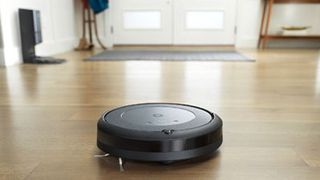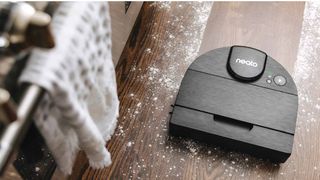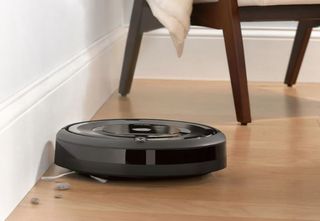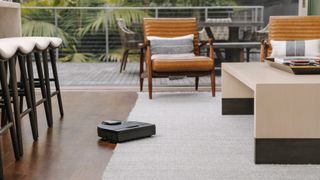iRobot Roomba Vacuum vs Neato: which robot vacuum should you buy this Black Friday?
Should you choose Roomba or Neato if you want to automate your floor cleaning?

Robot vacuum cleaners are a great addition to the home, being relatively affordable and freeing up your time to spend with the family, catch up on work and leisure. Generally speaking, the best robot vacuum cleaners are as effective as a cordless vacuum and can last for an hour or more before needing a recharge. Some even return to their charging base when running low on power, while some can even empty their own dust containers, saving their owners from an unpleasant task.
With all these advantages, it’s little wonder the robot vacuum cleaner market continues to grow at a rapid pace: Statista reports that global sales of robot vacuums numbered $256 billion in 2019, and predicts the market will grow by 17.7% over the next six years, according to market research firm Statista.
Right now is a popular time of year to buy a robot vacuum cleaner as they are heavily discounted over Black Friday and Cyber Monday, which makes them even more attractive. iRobot’s Roomba and Neato are two of the biggest names dominating the robot vacuum market right now, so it makes sense to plump for one of these brands.
iRobot’s Roomba had a head start by launching the first consumer device waaaay back in 2002. Loaded with cutting-edge technology that ensures the robovacs operate autonomously, Roomba models may come with a hefty price tag, but still prove popular. In fact, the brand claims that 20% of all robot vacuums sold are iRobot models.
Neato, meanwhile, is a much younger company having only launched its first robot vacuum in 2010. It was the first brand to offer integration with Amazon’s Alexa app with its Botvac Connected robot vacuums, a development that means users can literally tell their robot where to start and stop cleaning. Many robot brands now offer app support options, either through Alexa and IFTTT or Google Assistant. Neato’s models are cheaper than iRobot’s, with their most expensive model, the D10, costing $799/ £949 compared to the top-end Roomba at $1,099.99 / £1,499.99 / AU$2,899, although they’re not available in Australia whereas iRobot’s are.
So when you’re picking through the Roomba Black Friday deals and other robot vacuum deals this year, which brand should you plump for? It really depends on what you’re looking for in a robot vacuum.
Best iRobot Roomba and Neato deals
Read on to discover how these two robot vacuum brands compare – or, if you’ve already decided which of the two you wish to buy, check out the best prices right now:
Get daily insight, inspiration and deals in your inbox
Get the hottest deals available in your inbox plus news, reviews, opinion, analysis and more from the TechRadar team.
Range
There are seven models in iRobot’s Roomba range that are available worldwide, with the suction power and level of smarts being the clear differentiation between the designs. The iRobot S9 is the top-of-the-range model and is 40x more powerful when it comes to suction than the Roomba 694 – the brand’s entry-level robovac, which is known as the Roomba 698 in the UK. The S9 is also more methodical when cleaning, taking a logical path around your home, while the 694 employs a random route, which can mean cleaning takes longer.
Below the S9, sits the Roomba J7 - the brand’s newest model, along with the i3 and i7. All four of these models come in two variations; a standard model and a self-emptying model, which feature a + in the name. These higher-tech versions come with a base station that includes a disposable bag designed to hold up to 30 days worth of debris. The robot vacuum will empty the contents of the dust canister into the bag automatically, so all you have to do is remove the disposable bag once a month.
When it comes to smarts, each design offers a number of features including voice control and the ability to map your home so you can schedule cleans for specific rooms as well as the whole floors. Some even allow you to create no-go areas the robovac won’t enter.
The J7 is the smartest of all Roomba models and can identify and navigate around obstacles on the floor, such as a charging cable or dog poop. In the US, iRobot also offers a robot vacuum that can mop your floors as well as vacuum them.
Neato has fewer models in its robot cleaner line-up, with three Intelligent offerings, the D8, D9, and D10, each of which comes with useful customization options, store multiple floor plans and use LIDAR mapping, while Neato models that don’t bear the Intelligent tag – the D4, D6, and D7 – are termed ‘classic’ smart robots by the company. LIDAR mapping uses lasers to map your rooms, rather than the cameras found on rival brands and which have caused some consternation about how securely images may be stored online. In general terms, the cheaper models in Neato’s smart and Intelligent ranges are aimed at customers with less floor acreage to cover – for example, the D8 offers coverage of up to 750sq ft – while the pricier models can clean more than 2,500 sq m before needing to be recharged. The robot vacuums in iRobot and Neato’s ranges all work with Alexa and Google Home Assistant, and can be controlled via the MyNeato app. Neato offers automatic feature updates to the Intelligent models.
A particular selling point of the D7 Botvac Connected model (since adopted for Neato’s subsequent robot vacuum cleaners) is the No Go Zones area-blocking ability. Using the app the D7, D8, D9 or D10 owner can designate part of a room off-limits simply by drawing a line to block out that section on a map of the room, potentially preventing entanglements with toys, pet food bowls, and artfully placed houseplants.
The very latest Neato models, the D8, D9, and D10, focus on their ability to detect and clean dust particles as small as 10 microns and get rid of any pet hair. HEPA allergy filters get rid of allergens released when cleaning is in progress. They also have very wide brushes to clean to the very edges of a carpet or floor, plus a turbo mode for when extra suction is needed. However, unlike iRobot, no automatic emptying option is included.

Price
So what will it cost if you want to get your hands on a robot vacuum and outsource your floor-cleaning? Plumping for an iRobot Roomba model is slightly more expensive than choosing a Neato model, but you may decide that the convenience of a self-emptying dust canister system offsets the cost difference.
The entry-level iRobot Roomba 694, which as we’ve already mentioned is known as the 698 in the UK and 692 in Australia costs $274.99 / £269.99 / AU$499, while the i3 Series, the most affordable option with some smarts built in, is priced at $399.99 / £449.99 / AU$999.99 although it’ll set you back $599.99 / £699.99 / AU$1,399.99 if you want the self-emptying model.
The recently-announced J7 costs $649.99 / £699.99 / (around AU$900), while this rises to $849.99 / £899.99 (around AU$1,175) for the J7+, which empties its own dust canister. The top-of-the-range S9+ is one of the most expensive robot vacuums we’ve tested and will set you back an eye-watering $1,099.99 / £1,499.99 / AU$2,899.
The Neato D10 at $799.99 / £949 is aimed at those with larger homes while the D9, doesn’t offer as powerful suction and is aimed at medium-sized homes but this is reflected in the slightly cheaper price tag of $699.99 / £799. The entry-level robot in Neato’s Intelligent range, the D8 is for smaller homes up to 750sq ft and costs $599 / £749.
If you need a good value model that offers more extensive floor coverage on a single charge, but don’t need as many features, look to Neato’s classic smart robots: both the D7 for larger homes and the D6 for small-to-medium-sized homes will set you back $499.99 / £449.99. Although these have fewer mapping options than their more expensive stablemates.

Features
Both iRobot's Roomba and Neato are evenly matched when it comes to the basic functions you’d expect from a robot vacuum. All of their models will pootle around your home unaided collecting dust, dander, and larger debris from your floors, and map your home so they know exactly where they are cleaning.
iRobot’s Roomba’s are loaded with functions that ensure you really can outsource the vacuuming, such as a Dirt Detection feature, which will automatically spend more time cleaning a section if the robot vacuum identifies there’s more dust than usual, as well as the i7 and above’s ability to sense when you’ve left the house and start cleaning, returning to its base when it detects you’ve arrived back home.
Neato’s D9 and D10 Intelligent robot models also focus on privacy, using lasers as sensors rather than cameras to detect obstacles and create maps of your rooms. This means that actual images of your home are not stored in the cloud (where hackers could potentially intercept them), an approach that will be welcomed by those concerned about possible privacy issues resulting from smart tech that captures photos and videos of your home.
An important design difference between iRobot and Neato is the D-shape form factor of the latter. Reasoning that a curved shape cleaner will be unable to access corners, Neato makes much of its robots’ ability to get at hard-to-reach grot and grime. As with iRobot, Neato has boosted the power of its latest models, claiming a concomitant boost in dust-busting of 40%.

Verdict
Both iRobot and Neato ‘s robot vacuums do a good job at sucking the dust and dirt from carpets and hard floors in homes unaided. For those that want to really hand the vacuuming over to someone else, iRobot’s models come loaded with smart to ensure they never get in your way when they’re cleaning, avoid obstacles and even work out areas that need a deeper clean.
Meanwhile, Neato is focused on the privacy issues associated with app and Wi-Fi-connected robots, plus its vacuum’s powerful cleaning regimes and anti-allergen credentials. It was the first to offer obstacle exclusion options in its intelligent, app-based robot vacuums, plus a D-shaped design that’s effective at getting dust out of awkward corners. However, the really advanced, self-emptying bin options are missing from its range.
iRobot has had its own way in the robot vacuum cleaner market for many years, offering seven different models that ensure it has a model in every price segment, from the top end S9+ with its companion robot mop to the £250 budget sector.
However, not everyone will want or need the ultra-convenience of the self-emptying bag and base. Looking a little lower down from the flagship Roomba models, it’s perfectly possible to find a sub-£500 robot cleaner that effectively cleans your floors and can still be called up on demand or to a preset weekly schedule. Neato’s latest models, meanwhile, address both battery life and privacy issues, pitching to wised-up customers and those with larger properties needing regular maintenance.

- Check out these great robot vacuum deals

Rosie Hattersley has been writing about technology and how to use it for more than two decades for titles such as PC Advisor, Computeractive and Macworld. Despite living in a houseful of digital radios and streaming devices, she still likes old-school tech and has sizable collections of CDs and vinyl. A fan of crafting and upcycling, she’s a regular contributor to maker community magazine Hackspace and Raspberry Pi-focused The MagPi. Rosie enjoys live music, vegetarian cooking, campervanning adventures and unexpectedly long walks.
Most Popular


